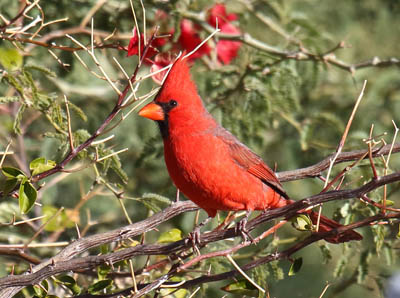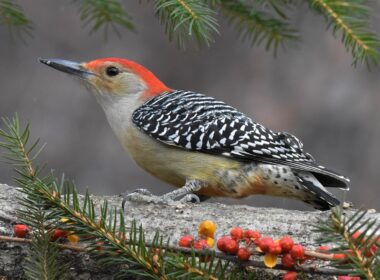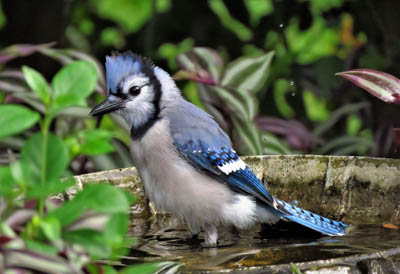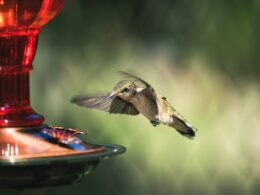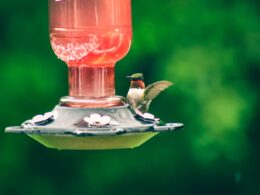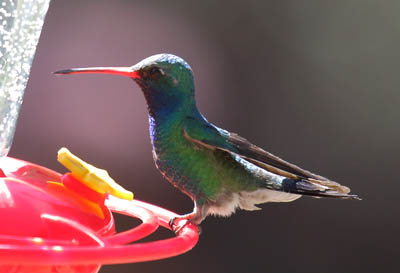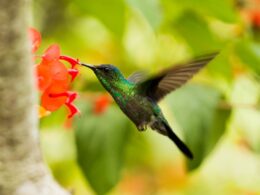Last Updated on January 20, 2024 by Greg Gillson
Uh-oh. Bees have found the hummingbird feeder and have taken over. Now what do you do? How do you get rid of bees from your hummingbird feeder?
It is best to prevent bees from invading your hummingbird feeders in the first place. After bees have found the feeder, though, there are also some things you can do to get rid of them.
To prevent bees from coming to your hummingbird feeder, choose the right kind of feeder, place the feeder in the shade, clean the feeder and prevent leaks, and get rid of any rotting trash or vegetables in your yard. Once bees have found your feeder you may have to remove the feeder, clean it, change the ratio of sugar water, and move the feeder to a different location.
 |
| A bumble bee and hummingbird at a hummingbird feeder Image by Fleece from Pixabay |
You may not care, but the yellow and black buzzing and stinging insects at your hummingbird feeder are probably yellow jacket wasps and not true bees.
I’ve gotten stung when I stepped on honeybees in the lawn as they innocently gathered pollen from the clover. But it’s been more decades than I care to admit since I ran barefoot through the clover.
Stings from honeybees are not as frequent as stings from yellow jackets.
More recently, but still in my youth, I ran over the hidden underground nest of yellow jackets while mowing the lawn. Unpleasant. Yellow jackets are the aggressive insects that ruin your late summer picnics as they try to eat your burgers and franks. These are likely the “bees” that have invaded your hummingbird feeder.
But, regardless, you want to avoid these stinging insects from driving off your hummingbirds!
In case you care…
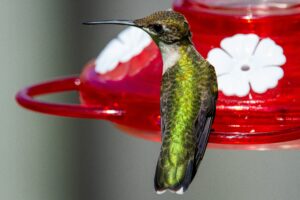
How to keep bees away from your hummingbird feeder
There are several things you can do to reduce that chance that bees come to your hummingbird feeder. Let’s talk about these one-at-a-time.
Clean up spills
Bees are after the sweet hummingbird nectar. They really love that sugar! Thus, you should do your best not to spill the hummingbird food when putting up your feeders after refilling. You should clean the outside of the feeders and rinse away any spills on the ground. This will help keep away bees and ants.
Choosing a hummingbird feeder that does not leak
There are two types of hummingbird feeders. One leaks; the other does not.
Inverted bottle hummingbird feeders tend to leak. These work by creating a vacuum air pocket inside the bottle. That vacuum holds the liquid until an air bubble gets in. Then a drop of sugar water falls out until the air pressure is equalized. As hummingbirds feed on the sugar solution, it is replaced by another bubble of air. There is always a drop of nectar on the tip of the feeding port ready to fall off. This attracts bees.
Why use them? They can hold a large a large volume of hummingbird food fluids. So they don’t have to be refilled as often.
Saucer type hummingbird feeders have a bowl of nectar that the hummingbirds reach by sticking their bills down to reach the liquid. These do not leak. They have a cover over them so that hummingbirds can reach the food with their long bills and tongues. Bees cannot reach the sugar water.
Many hummingbird feeders are a combination of the inverted bottle and saucer type feeders. They hold more fluid. They don’t leak as much. I find the More Birds hummingbird feeders don’t leak. And you can choose the size that’s best for you (Ruby, Garnet, or Diamond).

Place hummingbird feeders in the shade
Bees prefer to feed in warm sunny locations. Hanging your hummingbird feeder where it is in the cool shade for at least part of the day may help keep bees away.
Hummingbird nectar also ferments faster in the sun. So it should last longer in the shade.
I recommend that you place the feeder so that it gets early morning sun, but shade in the heat of the day. I wrote a rather popular article about where to place your hummingbird feeder, discussing the sun or shade dilemma.
Nectar guards
Nectar guards are plastic screens that fit over the feeding ports. This keeps the bees away, while still letting the hummingbird’s bill reach in to the food.
Nectar guards are useful for keeping bees away from feeder ports on vacuum style hummingbird feeders. These aren’t usually necessary on saucer-type feeders.
Feeders may come from the manufacturer with nectar guards or bee guards pre-installed. Or, you can sometimes buy bee guards for the model of hummingbird feeder you already own.
Red vs yellow feeders
In general, bees are said to be more attracted to yellow than red. Thus, they may more quickly be attracted to hummingbird feeders that are yellow. Or bees may be more attracted to feeding ports decorated with yellow flowers.
How true this is in actual practice is unknown. Certainly, if sugar water is easily available, bees aren’t going to stay away because of the color of the container.
And hummingbirds aren’t necessarily attracted to red hummingbird feeders over any other color, either. It seems to be a marketing decision. People buy red hummingbird feeders more than other colors. [See my article: Why are hummingbird feeders red?]

How to get rid of bees at your hummingbird feeder
What, though, if despite your best efforts bees still found your hummingbird feeder? There are some things you need to do to get rid of them.
First of all, don’t use pesticides! Poison will kill other flying insects and spiders–a favorite food of hummingbirds. So you could poison hummingbirds while trying to kill bees.
You will probably want to wait until night when the bees go back to their hive. Early morning when it is cool may be good, too, for taking down the feeder.
Empty the feeder and wash and clean it thoroughly. Bees or other insects can contaminate the hummingbird nectar. So throw it out and start over.
Here are other things to do.
Move the feeder
Bees will keep coming back to a food source. Scout bees locate the food first, then go back to the hive or nest [definition: a beehive is a manmade bee nest]. They tell other bees where to find the food source. Honeybees do this by acting out a kind of dance. After that, all the bees will go to that location to look for the food. I am unable to locate information about how yellow jackets communicate food locations, but they are highly social and probably do the same dance.
Thus, the bees may return to the same location for a couple of days. So moving the feeder (how far? Sorry, I don’t know) is recommended by some as a way to keep the bees from coming back right away.
Remove trash from your yard
Yellow jackets eat meat and sugar. They smell food, so it is not enough to make sure your outdoor trash bins are firmly covered. Garbage should be bagged and the trash can washed and cleaned regularly. Clean up any rotting vegetables from your garden or lawn composting.
Change your hummingbird nectar sugar ratio
The ideal sugar content for hummingbird nectar is 20% (1 part white sugar to 4 parts water). Bees also like this sweetness. Hummingbirds will drink a sugar ratio as low as 15%. Bees may not be attracted to that diluted amount. Thus, after your feeder is taken over by bees do this. Clean the feeder and refill temporarily with 1 part sugar to 5 parts water (16.7% sugar). If you don’t have trouble with bees again right away, increase the sugar content back to 20% to make the hummingbirds happier.
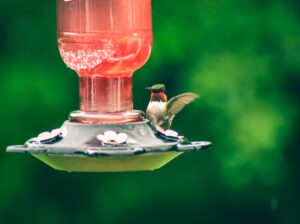
Wrapping Up
The relationship between bees and hummingbirds isn’t quite as simple as “getting along” or not. It’s more of a complex dynamic based on competition, resource sharing, and even the occasional squabble! Here’s a breakdown:
- Both bees and hummingbirds feed on nectar, a sugary liquid found in flowers. This creates competition for these valuable resources, especially where flowers are scarce.
- Hummingbirds, with their agile hovering and long beaks, are often more efficient at extracting nectar than bees. This can leave less for the bees, increasing their competition.
Frequently Asked Questions
What is messing with my hummingbird feeder?
While bees and ants are attracted to hummingbird feeders for the sweet nectar, they can indeed cause damage and become unwelcome guests. Here’s how:
Ants:
- Clogging the feeder: They can crawl into the feeder’s feeding ports and clog them with their bodies, making it difficult or impossible for hummingbirds to access the nectar.
- Contaminating the nectar: Ants can introduce bacteria and other microorganisms into the nectar, potentially spoiling it and making it unsafe for hummingbirds to consume.
- Driving away hummingbirds: Large numbers of ants can be intimidating and even aggressive towards hummingbirds, driving them away from the feeder.
Bees:
- Competing with hummingbirds: Bees can compete with hummingbirds for the nectar, reducing the amount available for the intended visitors.
- Drowning in the feeder: Some bee species can drown in hummingbird feeders that have deep reservoirs or lack proper drainage features.
- Stinging hummingbirds: While rare, aggressive bees might sting hummingbirds, especially territorial males defending the feeder.
Will Vaseline keep ants away from hummingbird feeder?
It’s strongly recommended against using Vaseline or any other greasy or oily substance like petroleum jelly to keep ants away from your hummingbird feeder. While it may seem like a quick and easy solution, it can actually have several harmful consequences for the hummingbirds:
Harm to hummingbird feathers: Vaseline can get on the hummingbirds’ feathers when they visit the feeder. This can mat their feathers, making it difficult for them to fly and regulate their body temperature. In severe cases, it can even lead to hypothermia or death.
Reduced ability to preen: Hummingbirds preen their feathers constantly to keep them clean and waterproof. If their feathers are coated in Vaseline, they won’t be able to preen effectively, further impacting their ability to fly and stay warm.
Increased risk of infection: Matted feathers can trap dirt and moisture, creating a breeding ground for bacteria and fungi. This can lead to skin infections and other health problems for the hummingbirds.
Can I spray vinegar on hummingbird feeder?
It’s generally not recommended to directly spray vinegar on your hummingbird feeder for the following reasons:
Strong vinegar smell: Undiluted vinegar has a strong acetic acid smell that can repel not only ants but also hummingbirds. They have a keen sense of smell and might avoid the feeder altogether.
Potential damage to the feeder: If your feeder is made of certain materials, like plastic or painted metal, strong vinegar can cause discoloration or even damage the surface over time.
Related:
Why don’t hummingbirds come to my feeder?



